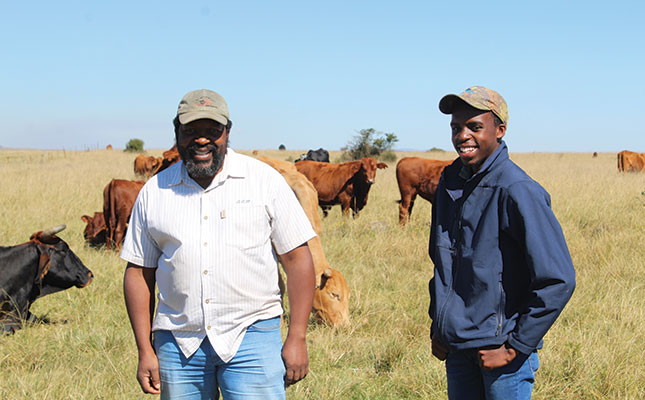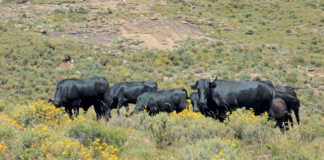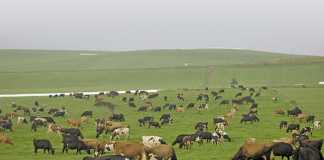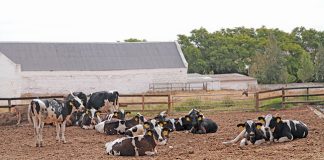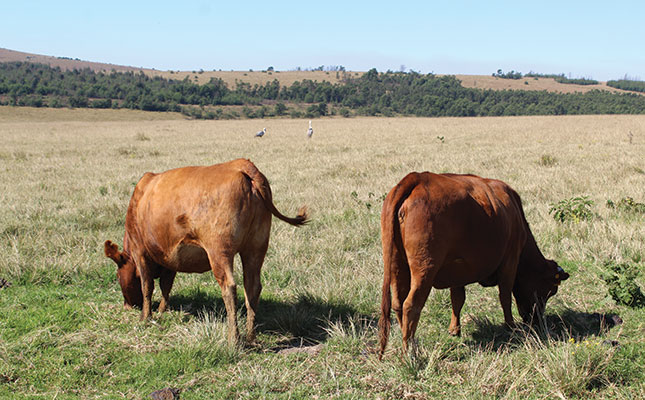
Photo: Lindi Botha
Second- and third-generation beef producers Robert and Sanele Khumalo farm on Elandsfontein, close to Mooi River in KwaZulu-Natal. Their farm covers 256ha, with another 300ha leased to accommodate their herd of 600 Beefmaster X Brangus cattle.
The Khumalos are hands-on livestock farmers, and manage the feeding, breeding and herd health of their animals with precision. This has seen them build up and maintain a sustainable operation despite recent challenges, chief of which are too much rain and too little land.
Elandsfontein receives ample rain, providing decent grazing for most of the year. Although this rain is obviously welcome, the Khumalos need to pay close attention to the nutrition their cattle receive to ensure optimal performance.
“Rain influences the nutritional value of the grass, and this year, where more than 2 000mm have fallen so far, the nutritional density of the grass is less. The cattle therefore require an energy lick to keep them in top shape,” says Robert.
The farm is divided into camps, with stocking density varying according to pasture quality. In general, though, the Khumalos follow a rate of 1 MLU/ha, increasing the density when rainfall has been particularly good and decreasing it to about 1 MLU/1,5ha in relatively dry conditions.
How long the cattle are kept in each camp before being moved is dependent on the relative height and condition of the grass. Sanele spends much time in the veld assessing its condition.
“In summer, we rotate the cattle every two weeks because the grass shoots up very quickly after being grazed. In winter, the period that the veld needs to recover is longer. Keeping an eye on the length of the grass is important to ensure the veld isn’t overgrazed,” he says.
The farm has a mixture of sweet- and sourveld. There is no planted pasture, but 40ha is planted to maize silage as supplementary feed in the winter. The Khumalos plant silage at the beginning of December and cut it in May, thereafter feeding it primarily to the cows with weaners.
Rainfall turns problematic
Sanele says that the exceptionally high rainfall of recent months has brought a number of problems.
“Last summer, we had so much rain that we had to dip the cattle more often against diseases, especially liver fluke. This pushed up our medicine bill, affecting our bottom line.”
In summer, the cattle are generally dipped every fortnight, although last year this increased to once a week.
To make the process less stressful and dangerous for the animals, Robert has replaced the plunge method of dipping with an innovative spray system, where the animals simply file through a corridor fitted with spray nozzles. This is especially useful in the case of cows that are in-calf, which risk injuring their unborn calves when jumping into a dip tank.
Sanele notes that stress plays a major role in the overall health of the cattle, and reducing stress load is vital to a flourishing herd.
Commenting on the recent increase in rainfall, Sanele says that the effects of climate change are becoming evident on the farm and posing one of the biggest challenges they face.
“Planning the production season has become difficult because the weather is so erratic. We can’t plan too far in advance. Besides the rainfall being high, it also arrives later [in the year], resulting in a lot of frost in the mornings.
“The winters are also much colder, which influences how we manage the calves. We’ve had to set up calving camps for winter in warmer areas on the farm, and need a lot more feed during this time to pull the calves and their dams through. We therefore try to stick to a summer calving season when more feed is available.”
The right breed
Robert grew up among his father’s Nguni herd, and today a handful of the beautiful speckled cattle can still be seen in the Khumalos’ herd.
“They’re still here from my father’s time, so they’re quite old, but I like to keep them around as a reminder to me, and my sons, of where we all started. They’re part of our family history.”
While sentiment may lie behind retaining the few Nguni cattle, it was sound business principles that drove Robert to expand his herd with Beefmaster and Brangus crosses.
A building contractor by trade, Robert saved up to buy his first herd of cattle in 2001. These were predominantly Beefmaster-Bonsmara crosses. He then added a Brangus component to increase the physical size of each head of cattle to get more kilogrammes of meat per animal. After weighing up the pros and cons of each breed, he finally settled on a Beefmaster-Brangus cross.
“This cross produces a decent-sized frame, and they put on weight quickly, which gives me more meat. The Beefmaster adds more beef while the Brangus adds length. The cross also provides good milk production in the cows, so the calves have far more potential to grow.”
In addition, its feed conversion ratio is good, which makes it attractive to feedlots.
When selecting bulls, Robert looks for a long, straight line across the top, a wide mouth, and strong legs. It’s important that the bulls are not overly large or too heavy for the cows during mating.
Sanele adds that improving a herd also includes replacing cows that don’t perform. The Khumalos work closely with their veterinarian during calving season to ensure that the cows are in good shape and the season runs smoothly.
Heifers are mated at 18 months of age, down from the initial 24, as the Khumalos prefer to get their heifers into production sooner. Sanele explains that this decision was also taken because the heifers come on heat at 18 months and become restless, jumping fences to get to the bulls.
“Placing them in one camp just made sense and was far easier than trying to keep them apart.”
A ratio of one bull to 25 cows is used. There are also a few spare bulls to ensure that mating can continue if there are any problems with a bull. Robert uses his own bulls to service the cows, buying in a new bull every year, depending on auction prices. He sets a limit for how much he can spend to avoid reducing his return on investment.
The cows are placed in the camp with the bull for three months, starting on 15 November, and the bulls are removed on 15 February. This programme results in the cows all calving within three months of each other and in summer, when grazing is good. This in turn ensures that cows can produce ample milk and weaning rates will be adequate.
The Khumalos aim for a conception rate of 92%, but achieved only 79% last year. This, however, was no worse than most other farmers in the area, as animal health suffered generally due to the high rainfall.
Calves are weaned at eight months at between 240kg and 260kg, and Robert decides which will be sold to feedlots and which will be used as replacement animals. For this selection process, Robert values the advice of Sanele and a group of farmers from the area, and they all debate the matter together.
All cows, regardless of their condition, are replaced when they reach eight years old.
The next generation
Robert counts himself lucky to have one son on the farm, and another who will join them once he finishes school. Sanele grew up at his father’s side, spending all his free time on the farm, and has farmed full-time since matriculating from Weston Agricultural College two years ago. Despite the industry’s many challenges, there is nothing else that he would rather do.
He admits that while being a third-generation farmer comes with its advantages, such as generational knowledge, having two people farm the same land can be challenging.
“We’re from two different generations and have different ideas. But I’ve discovered in the last two years that nothing beats experience. I learnt a lot at school, but when I came back to the farm I saw that the theory didn’t always relate to what was happening on the ground.”
Robert has gone to great lengths to instil the importance of farming in his sons.
“Too many people are running away from farming and out of the country. Who’s going to take [their place] and supply food to South Africa? If there’s no farming, there’s no future. We see across Africa the countries where food production is limited, and people are hungry and poor. We need all the farmers we can get.”
Lack of affordable land
He nonetheless laments the rising input costs and lack of available land to expand production.
“We have to let go of a lot of heifers we’d prefer to keep because the farm is at full capacity. Without more land, we can’t expand the herd and ensure that the cattle are in tip-top condition. Stocking rates influence conception, calving and weaning rates, which ultimately affects the bottom line. But there just isn’t any land available, and when there is, it’s very expensive. With my sons entering the business, it’s especially important to expand the farm to ensure there’s space for everyone to spread his wings.”
The Khumalos note that the shortage of land also has an impact on transformation in the industry.
“The number of black farmers hasn’t really increased over the past 10 years,” says Sanele.
“Those who’ve tried to get going on land provided by the state struggle because they have no tenure, so they can’t get a loan to start production.”
He adds that much land owned by government is lying fallow, and because it is not being put up for sale, it is simply going to waste.
“At one stage, 54 farms were leased by the state in this area. We saw many farmers come in, try, but struggle to succeed without capital or loans.”
Email Robert Khumalo at [email protected].

